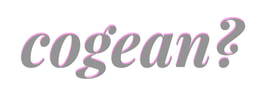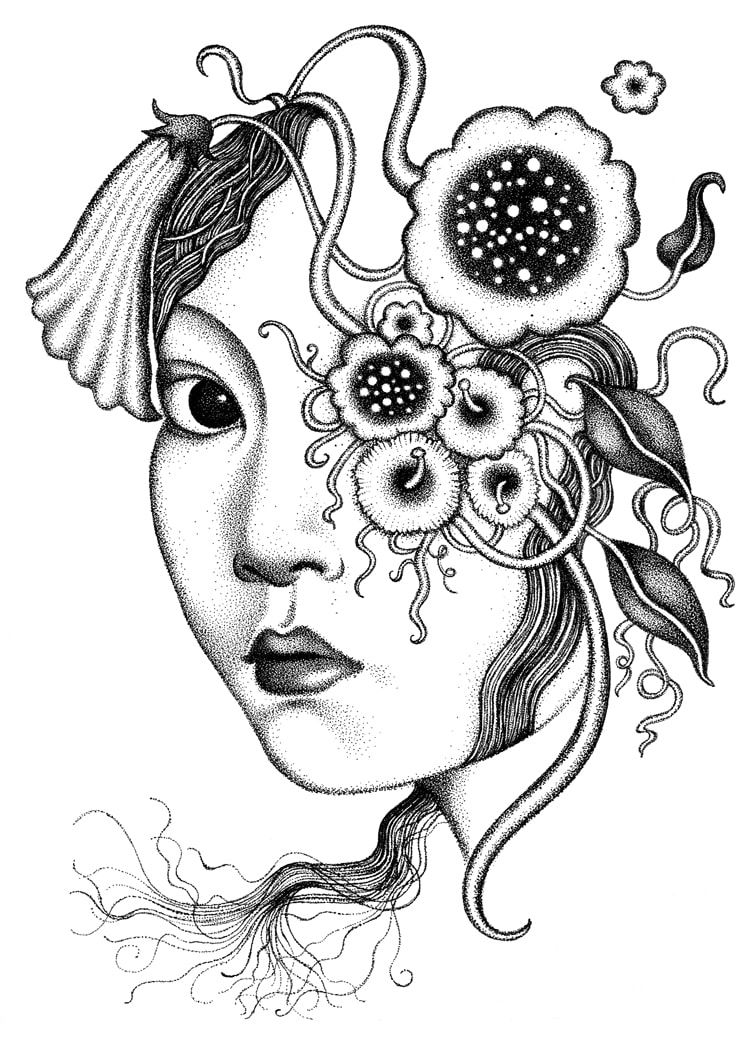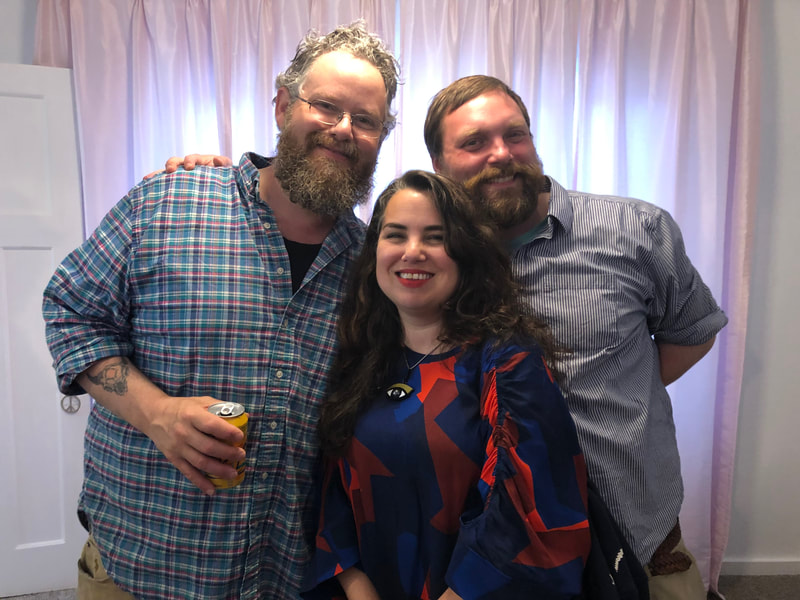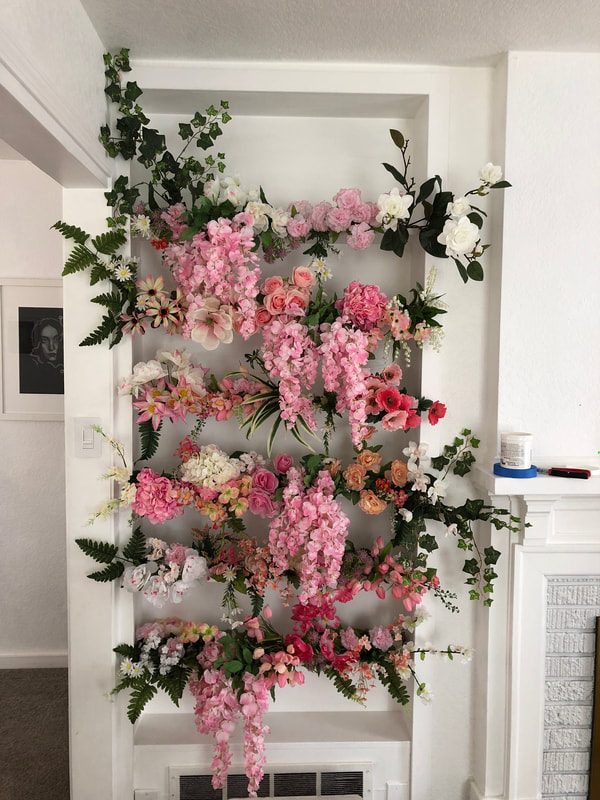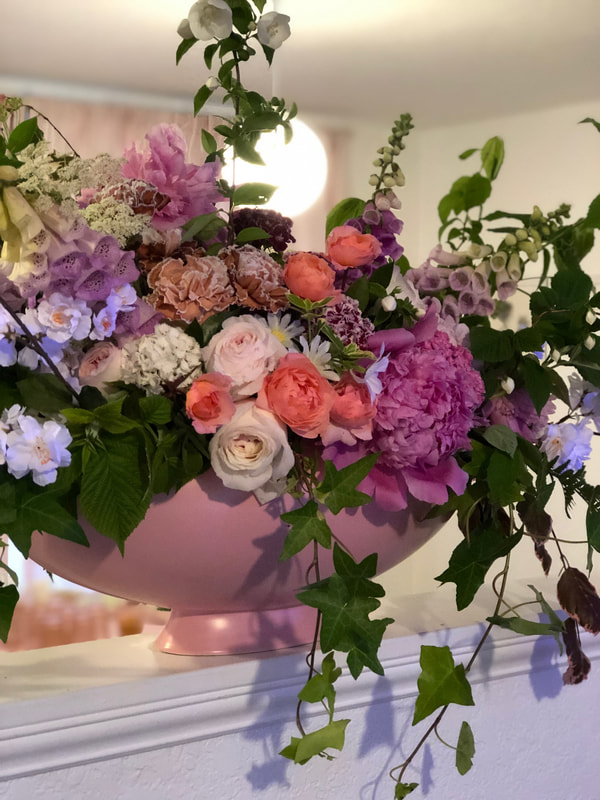This new series of work is informed by Klingels' years of employment in the floral industry. These delicate and obsessively detailed drawings consider the commodification of nature, the invention of desire, economic bubbles, impossible bouquets, girls hiding in horror films, what Elon Musk dreams about and what will happen to the flowers we have planted after we're gone.
Please join us:
Friday, June 7th, 6-9pm, Opening Reception
Saturday, June 8th, 11-2pm, Artist Brunch
Saturday, July 20th, 11-2pm, Closing Reception
- and by appointment -
Friday, June 7th, 6-9pm, Opening Reception
Saturday, June 8th, 11-2pm, Artist Brunch
Saturday, July 20th, 11-2pm, Closing Reception
- and by appointment -
Dark Water, 2019, 6 x 9 inches, Isvald Klingels
Interview with Isvald Klingels
cogean?: Poison Garden—can you elaborate on this poetic title?
Isvald Klingels: A poison garden is a place that grows beautiful but deadly or intoxicating plants. In this new work I wanted to process some of my thoughts and experiences of the floral industry, which creates a mirage of natural perfection built on petrochemicals, pesticides and exploitation. In the US, many of the flowers we use are grown in South America by (largely female) workers exposed to dangerous pesticides. As florists, we are handling beautiful flowers drenched in invisible poison for customers who demand unblemished, flawless petals. Some years ago I was serving a father and his two children in a flower shop, showing them roses, and one of the small children reached out to touch one. The father reacted in horror, warning the child not to touch them as they were covered in pesticide. I was really fascinated by the naked selfishness of his reaction - he was obviously aware of the dangers but felt quite happy to point them out in front of a worker who handles these flowers all day. Of course the risk to the consumer is negligible: the hazard lies in repeated exposure. There is a growing slow flower movement, advocating seasonal, sustainably farmed blooms, but like organic food, it's expensive and out of reach for many people. I also wanted to explore the relationship between flowers and idealized femininity, and the romantic symbolism of flowers. Many of traditional femininity's most desirable attributes - vulnerability, fragility, prettiness, softness, fragrance and delicacy are mirrored in flowers. Flowers, as a commodity, tell a story of colonization and capitalism, boom and bust. In 17th Century Holland (then the world's leading economic power), tulip mania sent prices of tulip bulbs, recently introduced from the Ottoman Empire, skyrocketing - leading to the first recorded speculative bubble. Roses, one of the most intensively farmed and bred flowers, are synonymous with romantic love and account for around 35% of all cut flower sales in the US, but only 1% are grown here. And, of course, we are all living in a poison garden of our own creation, consuming pesticides in our breakfast cereal, carcinogens in our water and microplastics in our salt. One day, when we have poisoned ourselves out of existence, the flowers will rise again and take over the earth because they are more resilient than we are, and more adaptable. Although human civilization has eradicated 50% of wild plant species, humans actually only account for 0.01% of all living things, with plants making up 82% of all life on this planet.
c?: What does Elon Musk dream of?
IK: There's a drawing in this show called "Elon Musk Dreams of Space from his Mansion in Bel Air". It's about his dreams of space colonization, which he apparently considers the only way to mitigate mass extinction. I think the idea is that once we have so thoroughly poisoned this planet that it can longer support human life we should send a (presumably elite) team of Musk-like humans to colonize the Solar System and then repopulate Earth, thus carrying the torch of human culture onwards - or inflicting ourselves like a virus on the pristine, infinite cosmos, depending on your point of view.
c?: Where do you find inspiration?
IK: Here and there, hither and thither (sorry, I've been listening to a lot of 19th Century literature preparing for this show.)
c?: We imagine your artistic practice spills over into your day job as a florist. And it sounds like your florist job influences your artistic practice. What are the areas where they overlap like?
IK: I really love working with flowers. Floristry is very creative and it's taught me a lot about color and composition. It's interesting to work in 3D, and I like trying to make the most aesthetically pleasing things that I can with the materials available. It's also good for checking your artistic ego because, as clichéd as it might be, nothing is as beautiful, original or inventive as nature.
c?: You’ve had a busy past year. Will things slow down soon?
IK: I have had a busy year. I like making things and don't have any plans to stop. I might get a massage though!
c?: How’s it going in Bremerton?
IK: It's going really well. I love Bremerton.
c?: How much of your drawing do you get done on the ferry? Is that a surprising place to work?
IK: The ferry is one of my favorite places on Earth. I get a lot of drawing done on the ferry. The mornings are the most productive. It's a magical gift to have an hour to draw before starting work. The journey is very beautiful and I never want it to end.
Isvald Klingels: A poison garden is a place that grows beautiful but deadly or intoxicating plants. In this new work I wanted to process some of my thoughts and experiences of the floral industry, which creates a mirage of natural perfection built on petrochemicals, pesticides and exploitation. In the US, many of the flowers we use are grown in South America by (largely female) workers exposed to dangerous pesticides. As florists, we are handling beautiful flowers drenched in invisible poison for customers who demand unblemished, flawless petals. Some years ago I was serving a father and his two children in a flower shop, showing them roses, and one of the small children reached out to touch one. The father reacted in horror, warning the child not to touch them as they were covered in pesticide. I was really fascinated by the naked selfishness of his reaction - he was obviously aware of the dangers but felt quite happy to point them out in front of a worker who handles these flowers all day. Of course the risk to the consumer is negligible: the hazard lies in repeated exposure. There is a growing slow flower movement, advocating seasonal, sustainably farmed blooms, but like organic food, it's expensive and out of reach for many people. I also wanted to explore the relationship between flowers and idealized femininity, and the romantic symbolism of flowers. Many of traditional femininity's most desirable attributes - vulnerability, fragility, prettiness, softness, fragrance and delicacy are mirrored in flowers. Flowers, as a commodity, tell a story of colonization and capitalism, boom and bust. In 17th Century Holland (then the world's leading economic power), tulip mania sent prices of tulip bulbs, recently introduced from the Ottoman Empire, skyrocketing - leading to the first recorded speculative bubble. Roses, one of the most intensively farmed and bred flowers, are synonymous with romantic love and account for around 35% of all cut flower sales in the US, but only 1% are grown here. And, of course, we are all living in a poison garden of our own creation, consuming pesticides in our breakfast cereal, carcinogens in our water and microplastics in our salt. One day, when we have poisoned ourselves out of existence, the flowers will rise again and take over the earth because they are more resilient than we are, and more adaptable. Although human civilization has eradicated 50% of wild plant species, humans actually only account for 0.01% of all living things, with plants making up 82% of all life on this planet.
c?: What does Elon Musk dream of?
IK: There's a drawing in this show called "Elon Musk Dreams of Space from his Mansion in Bel Air". It's about his dreams of space colonization, which he apparently considers the only way to mitigate mass extinction. I think the idea is that once we have so thoroughly poisoned this planet that it can longer support human life we should send a (presumably elite) team of Musk-like humans to colonize the Solar System and then repopulate Earth, thus carrying the torch of human culture onwards - or inflicting ourselves like a virus on the pristine, infinite cosmos, depending on your point of view.
c?: Where do you find inspiration?
IK: Here and there, hither and thither (sorry, I've been listening to a lot of 19th Century literature preparing for this show.)
c?: We imagine your artistic practice spills over into your day job as a florist. And it sounds like your florist job influences your artistic practice. What are the areas where they overlap like?
IK: I really love working with flowers. Floristry is very creative and it's taught me a lot about color and composition. It's interesting to work in 3D, and I like trying to make the most aesthetically pleasing things that I can with the materials available. It's also good for checking your artistic ego because, as clichéd as it might be, nothing is as beautiful, original or inventive as nature.
c?: You’ve had a busy past year. Will things slow down soon?
IK: I have had a busy year. I like making things and don't have any plans to stop. I might get a massage though!
c?: How’s it going in Bremerton?
IK: It's going really well. I love Bremerton.
c?: How much of your drawing do you get done on the ferry? Is that a surprising place to work?
IK: The ferry is one of my favorite places on Earth. I get a lot of drawing done on the ferry. The mornings are the most productive. It's a magical gift to have an hour to draw before starting work. The journey is very beautiful and I never want it to end.
Living with Isvald Klingel's Poison Garden
It’s officially summer and everything is blooming and green and glossy in the sun. The energy and enthusiasm for being outside and being a body at motion and in labor is high. As usual we’re working on shifting around the bit of landscape we’re now responsible for; putting more flower beds in the front yard and working to change it from a front yard to a front garden, and an English cottage garden if we do it correctly. It is currently a motley cluster of plants in various stages of neglect, shaggy, snaggly, twisted little things from garden center clearance racks. Nonetheless, now in the ground and receiving daily attention they’re showing their bold colors and wild floral forms.
Inside our home things are in bloom as well, strangely. Luxurious arrangements of blossoms spill out of containers on the ledges between the entry and the dining room and the living and dining room. And pouring forth from the built-in bookcases is a gorgeous tangle of colorful growth. The vast majority of this profusion of life is synthetic, all silk flowers and museum wax. Beautiful, still, free of life or odor; a stunning impossibility. Here and there in the lovely monstrosity of simulation is live greenery and flowers, blending in with their immortal neighbors and, Cassandra-like in their blending with the artificial growth, reminding so subtly the inexplicable difference in the perfection of life over its simulation.
Next to the bookcase and glowing/growing above the mantel is a constellation of neon dots glowing under the rays of a black light tube and forming into floral patterns. Above this hangs a large white ribbon, with the words Poison Garden painted on it.
On the the other walls of the gallery hang a series of exquisitely executed new works on paper, each in its own way a distillation of the complexity of imagery and concept created on the bookcase and mantle. Every painting is its own bubble galaxy, filled with a swirling of tiny dots, swarming together to form faces, flowers, and bones. Each is beautiful, but also in its own way, like the fake flowers and the glowing, ominous yet friendly letters over the mantle, a biotechnical horror in space. It’s this fusion imagery: biological, technological, and intergalactic, that brings the show forward as participating in the oracular traditional of art. With alluring and beautiful imagery, we are called to look upon the the works, and then called again once looking closer to consider what it is exactly we would be bringing with us as we seek to live among the stars. And as glorious and riveting as it is to envision a humanity living among the stars, the wise conclusion of Candide comes to mind: Perhaps there is something to taking the time to tend to our own gardens.
Inside our home things are in bloom as well, strangely. Luxurious arrangements of blossoms spill out of containers on the ledges between the entry and the dining room and the living and dining room. And pouring forth from the built-in bookcases is a gorgeous tangle of colorful growth. The vast majority of this profusion of life is synthetic, all silk flowers and museum wax. Beautiful, still, free of life or odor; a stunning impossibility. Here and there in the lovely monstrosity of simulation is live greenery and flowers, blending in with their immortal neighbors and, Cassandra-like in their blending with the artificial growth, reminding so subtly the inexplicable difference in the perfection of life over its simulation.
Next to the bookcase and glowing/growing above the mantel is a constellation of neon dots glowing under the rays of a black light tube and forming into floral patterns. Above this hangs a large white ribbon, with the words Poison Garden painted on it.
On the the other walls of the gallery hang a series of exquisitely executed new works on paper, each in its own way a distillation of the complexity of imagery and concept created on the bookcase and mantle. Every painting is its own bubble galaxy, filled with a swirling of tiny dots, swarming together to form faces, flowers, and bones. Each is beautiful, but also in its own way, like the fake flowers and the glowing, ominous yet friendly letters over the mantle, a biotechnical horror in space. It’s this fusion imagery: biological, technological, and intergalactic, that brings the show forward as participating in the oracular traditional of art. With alluring and beautiful imagery, we are called to look upon the the works, and then called again once looking closer to consider what it is exactly we would be bringing with us as we seek to live among the stars. And as glorious and riveting as it is to envision a humanity living among the stars, the wise conclusion of Candide comes to mind: Perhaps there is something to taking the time to tend to our own gardens.
